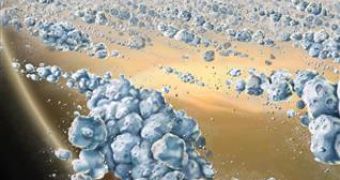Saturn's rings are one of its most distinct features, and although other planets in the solar system present rings of particles, they are not so obvious. They where first predicted to exist in the middle of the 17th century by Christian Huygens and viewed for the first time by Galileo Galilei with his telescope. Even today, the rings that surround the equatorial region of the planet can be relatively easy viewed with a pair of regular binoculars.
Previous assumptions on how they formed, their structure and age, suggested that Saturn's rings where no more than 100 million years old, their formed mostly of ice and dust particles in a layer no more than 20 meters thick, and must have formed from the remnant debris of embryonary moons that collided together. Data extracted from the Voyager 1 and 2 missions, sent to study the outer planets of the solar system, seemed to support the model; however recent missions such as the Cassini-Huygens spacecraft, reveal that the material inside Saturn's rings is as old as 4.5 billion years, and could be remnant debris leftover form the process of planetary formation.
Furthermore, the Cassini probe found clear evidence that the particles that form the rings are constantly evolving, breaking up and regrouping to form other structures inside the rings. This allows them to continually change, recycling material, thus remaining as old as the solar system.
Saturn's rings present special interest for the scientific community, as they form the largest such structure in the solar system and evolve in much the same way as the matter inside a forming solar system, thus could reveal valuable data of how the initial nebula consisting of dust and gas surrounding a star, evolves into a protoplanetary disk that could eventually create planets.
The structure of Saturn's rings is composed of seven distinct large concentric rings, consisting mostly of ice and dust particles, amongst which small bodies orbit and collect part of the matter that gives off the appearance of multiple rings.
Also by doing a sprectrography of the rings with the help of the light reflected from the stars behind them, Cassini revealed that indeed Saturn's rings might be a permanent feature of the planet, as previously predicted by certain scientists.

 14 DAY TRIAL //
14 DAY TRIAL //